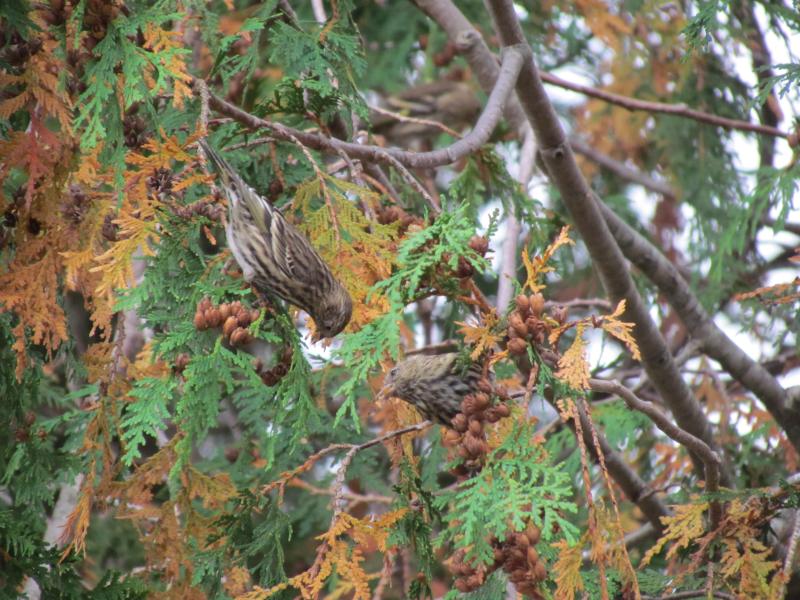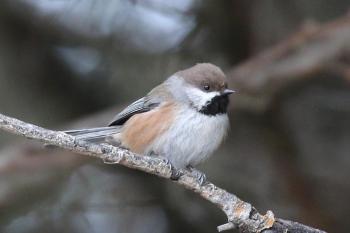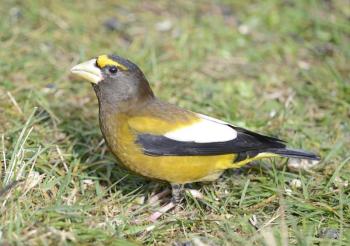A few weeks ago on a fine spring day, we were walking our little black dog around the neighborhood. Walking up the hill on one of our favorite routes, we stopped in our tracks to enjoy the exuberant singing of a pine siskin. It was invisible to us, hidden high in the thick green branches of a solitary spruce tree, perhaps a tree planted there 50 or 60 years ago amid the many maples, ashes, and occasional pine trees of the small-city landscape.
In the eastern U.S., a pine siskin is a bird of the North. A small, brown-streaked finch that comes south in flocks some winters from its breeding range extending across the Boreal Forest biome from Alaska east to Newfoundland and south to spruce-fir forests of Maine. In the West, pine siskins occur as permanent residents across the high elevation mountain habitats of the U.S. and south through Mexico to Guatemala.
Pine siskins do nest in Maine, but not here in our town and not anywhere close by. This bird was clearly a migrant that had just stopped for a time in the single tree that reminded him of the forest of spruces on the breeding grounds where he was headed.
We were delighted to enjoy his singing for the short time he would be here.
But then he added another depth to our enjoyment—a sort of secret message within his song. That message told a story of the landscapes that this bird knew so well. Landscapes of dark green spruce-fir forests stretching into the distance, the earthy rich smells of sphagnum moss and the fragrant scent of balsam floating in the cool air. Was it a memory and an anticipation of the return to that landscape that inspired him to add this secret message to its song?
Among the loud twitterings and shrill “shrees” of this pine siskin’s song there was something else: the husky “zick-a-djee” of a boreal chickadee! That’s a bird that we will very likely never see or hear in our neighborhood. A brown capped version of the black-capped chickadee, it virtually never ventures from the thick spruce-fir forests of northern and eastern Maine where it reaches its southern range limit. From there, boreal chickadees range north across Canada to Alaska.
Then this talented pine siskin added another secret message to its repertoire—the jangly “kleer” calls of evening grosbeak, another bird of the North. Very occasionally, we have had one or two evening grosbeaks flying over our home in migration, but they, too, are a bird that haunts the vast spruce-fir landscapes from northern Maine north across the Boreal Forest of Canada.
This little bird was sending a secret message to those of us who could understand it, that told us something about where it was from, abouts its summer home and its bird neighbors far away. It planted a vision in our minds as we stood on the street amid homes and the bustle of town, of a far-away place that was quiet and beautiful and fragrant. For an instant, we were there in that peaceful landscape with that pine siskin and his boreal chickadee and evening grosbeak neighbors.
What a gift!
You can hear what we heard by tuning in to our soundclip posted here:
Jeffrey V. Wells, Ph.D., is a Fellow of the Cornell Lab of Ornithology and Vice President of Boreal Conservation for National Audubon. Dr. Wells is one of the nation's leading bird experts and conservation biologists. He is a coauthor of the seminal “Birds of Maine” book and author of the “Birder’s Conservation Handbook.” His grandfather, the late John Chase, was a columnist for the Boothbay Register for many years. Allison Childs Wells, formerly of the Cornell Lab of Ornithology, is a senior director at the Natural Resources Council of Maine, a nonprofit membership organization working statewide to protect the nature of Maine. Both are widely published natural history writers and are the authors of the popular books, “Maine’s Favorite Birds” (Tilbury House) and “Birds of Aruba, Bonaire, and Curaçao: A Site and Field Guide,” (Cornell University Press).
































